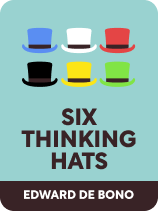

This article is an excerpt from the Shortform book guide to "Six Thinking Hats" by Edward de Bono. Shortform has the world's best summaries and analyses of books you should be reading.
Like this article? Sign up for a free trial here .
What is green hat thinking from Six Thinking Hats? What mode of thinking does the green hat represent?
In Edward de Bono’s book Six Thinking Hats, the green hat is the creative hat. The wearer of this hat is in charge of coming up with new ideas, whether they be realistic or outrageous. The goal of this hat is to push the boundaries of the team’s ideas without thinking of the risks or dangers.
Keep reading to learn how to use the green hat and why it’s so important for growth.
The Green Hat
Green is the color of new growth, and green hat thinking looks for new and original ideas. Though the attitudes that drive green hat and yellow hat thinking are quite similar (a sense of possibility; a desire to build rather than break down), the thinking styles involved are qualitatively different. For example, you might know someone who is very optimistic but quite conventional in their ideas. You might also know someone who is highly creative but not very optimistic. This is why we consider the green hat and the yellow hat separately in practice.
Green Hat Questions
While you’re wearing the green hat, consider these questions:
- How can I look at this problem differently?
- What new options can I generate?
- Where does this new idea take me? How far can I ride it?
- Do I recognize good ideas when I hear them?
Green Hat Data
Green hat data is anything completely new. When you put on the green hat, you’re coming up with combinations of ideas that, as far as you know, nobody has ever considered before.
Green hat ideas can range from novel but commonsense to completely outrageous, and all are welcome. Many successful ideas were fanciful or absurd in their original form and then brought down to earth through more practically oriented black hat and yellow hat refinements.
Relationship With the Yellow Hat: Construction vs. Creation
The relationship between the yellow hat and the green hat is interesting. Creativity benefits when it starts from a base of optimism and relaxation. It’s hard for your brain to be creative when it’s sensitized to danger and risk.
But yellow hat and green hat contributions are distinct. Yellow hat contributions are concrete and positive. When you have the yellow hat on, you’re systematically putting bricks into place. You know exactly what you’re building. Green hat contributions are more fragile. When you have the green hat on, you’re planting rare seeds, watering them, and seeing whether or not they sprout.
Though the yellow and green hats are complementary and can be used in tandem to generate and develop ideas, they’re not the same type of thinking.
Po and the Stone That Jolts the Wheel out of the Rut
Green hat thinking is about jolting yourself out of your normal thinking patterns. Think of a horse-drawn carriage being driven along a dirt track. Though the whole path is available to the carriage, it quickly settles into the ruts left by previous carriages. The wheels will stay in the ruts until they’re jolted out, either through an input of deliberate energy from the driver and horses or by an obstacle such as a stone.
Similarly, thinking will tend to follow normal, well-traveled pathways unless something gets put in the road. A provocation is a mental stone in the rut of normal thinking. A provocation might be something like “People should be paid to have pets” or “A manager’s subordinates should decide whether or not she gets promoted.”
Po, standing for “provocative operation,” is a word you can use to signpost a provocation. The deal is that you’re not allowed to meet a po with a black hat—you have to run with the suggestion. Here are some examples of po:
- Po roads should have a special motorbike lane.
- Po we should get rid of the whole HR department.
- Po office buildings in the CBD should all be torn down and replaced with parks.
The point of po is not to present a final idea. It’s to generate momentum. Jump on the back of the po and see where it takes you.
There are a few standard ways to generate po statements. The first is reversal. For example, usually tenants are penalized financially for damage to the properties they rent. Reversing this gives you: “Po tenants should be paid for looking after their rental properties well.”
The second is random word association. For example, let’s say that you want to generate ideas about rainforest conservation. You open a dictionary to a random page and find the word “window.” Perhaps this leads you to the idea of windows into a rainforest, which then leads you to the idea of setting up cameras in a rainforest that people can check online at any time, thus increasing people’s interest in the forest and motivation to conserve it. Or perhaps you want creative ideas about emotional health for stressed workers and you open the dictionary to “guitar.” A guitar has six strings at different levels of tension—perhaps people could sort their work tasks according to the level of tension they provoke and organize their days according to this. Or perhaps they could be encouraged to listen to calming music at work. Perhaps you could investigate whether the workers play an instrument and suggest they form a band and rehearse at lunchtime.
The random word association method can be surprisingly effective. Just introducing something new and seeing where it takes you can jolt you out of your cognitive rut and onto much more interesting and fertile terrain.
How to Use the Green Hat
- The green hat process can feel different to the others. While it’s usually not too hard to generate pieces of information and positive and negative analyses, completely new and creative ideas are different beasts. Sometimes, as hard as you try, you simply won’t be able to generate any interesting new ideas. Under the green hat, what matters is not the output volume but the time and effort that you’ve put in.
- Dedicate adequate time to the green hat. In contrast to the red hat, in which extra time just tends to muddy the waters, under the green hat time can be the difference between no ideas and excellent ideas. It’s normal for green hat sessions to start slow and build gradually.
- Keep the black hat far away. The black hat is poison for undeveloped idea seedlings.
Advice for Facilitators
- Don’t gatekeep wacky ideas, even if they seem completely useless. Note them down and see where they take you.
- Make sure to allocate time to the green hat, even if there’s no pressing problem to solve or pressure to develop a new idea. You never know what might arise.
- Train yourself and others to recognize good ideas when you see them. In many groups that have trouble being creative, the problem isn’t actually a failure to generate good ideas—it’s a failure to recognize and develop good ideas when someone suggests them.
Exercise: Try on the Green Hat
Work with the green hat on a problem of your choice.
- Consider the project or initiative that you’ve been thinking about in previous exercises. What’s the main issue? Can you sum it up in a few words?
- Put aside the specifics of the project for a moment. What completely new ideas can you come up with in this general area? Give yourself two minutes to start with, and keep going if you’re still generating ideas at the two-minute mark.
- Try out “reversal” po. Reverse one of the key tenets of your project and see what happens. For example: “My project is about koala habitat conservation. What if the koalas protected their own habitat?” (This could lead to a campaign where people learn about specific koala individuals and sponsor them, or to educational programs where kids learn about koala conservation from instructors dressed as koalas.)
- Try out “random association” po. For example, let’s say your project is about koala habitat and your random word is “spider.” Perhaps this reminds you of a spiderweb, and a spiderweb reminds you of networks, and this leads you to a social media campaign or a project to link different organizations working on koala conservation.

———End of Preview———
Like what you just read? Read the rest of the world's best book summary and analysis of Edward de Bono's "Six Thinking Hats" at Shortform .
Here's what you'll find in our full Six Thinking Hats summary :
- A handbook for training people to think more efficiently and productively
- An explanation of each of the six thinking hats created by Edward de Bono
- How to calm your inner critic and dramatically cut your decision-making time






